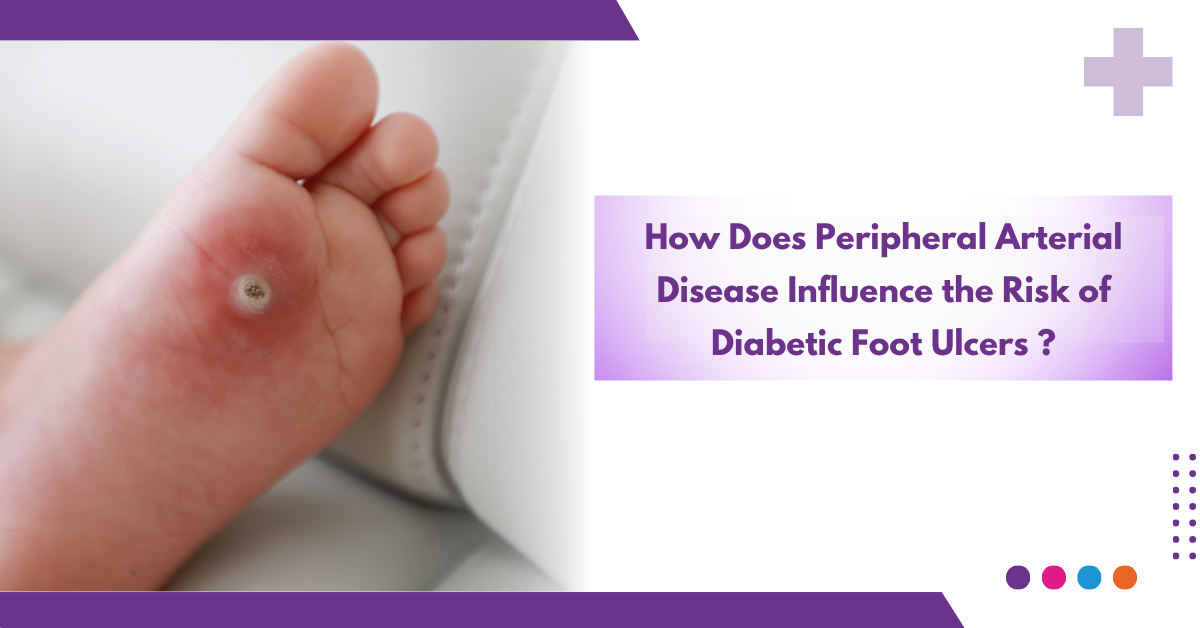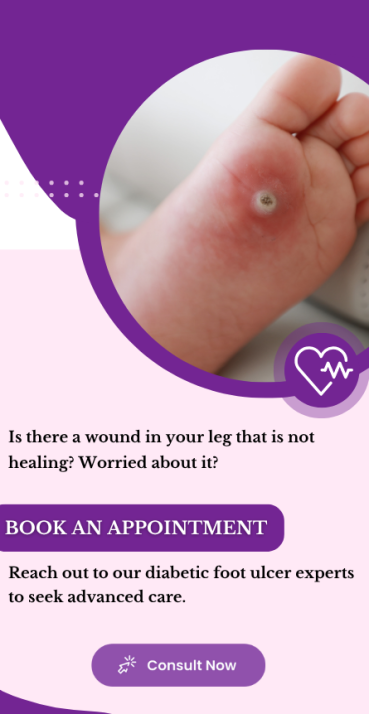
Foot ulcers are among the most common and serious complications in people living with diabetes. However, many are unaware of the hidden culprit that increases the risk of these ulcers. Diabetes has been on a rise, and recognizing the connection between Peripheral Arterial Disease (PAD) and foot ulcers can help people take early preventive steps and seek timely care.
If you have been diagnosed with diabetes or are caring for someone who has it, this blog will help you understand how peripheral artery disease worsens foot health and increases the chance of developing a nonhealing ulcer.
What should you know about Peripheral Artery Disease?
Peripheral artery disease is a condition where the blood vessels that supply your arms and legs get narrower because of a buildup of fatty substances. As a result, blood flow — especially to the legs and feet, gets restricted.
Poor circulation can delay wound healing, and when this happens in a diabetic person, it increases the risk of developing a diabetic foot ulcer. When the blood supply is weak, even a small cut, blister, or sore can quickly worsen into a deep, infected ulcer.
Peripheral artery disease happens when the blood vessels that supply your arms and legs become narrow because of a buildup of fatty deposits. This makes it harder for blood to reach areas like your legs and feet.
Poor circulation can delay wound healing, and when this happens in a diabetic person, it increases the risk of developing a diabetic foot ulcer. When the blood supply is weak, even a small cut, blister, or sore can quickly worsen into a deep, infected ulcer.
That’s why doctors recommend maintaining blood sugar in the normal range (usually between 70–130 mg/dL before meals) to help reduce complications.
How peripheral artery disease contributes to diabetic foot ulcers?
Here’s how peripheral artery disease worsens diabetic foot health:
Reduces Oxygen and Nutrient Supply: Peripheral artery disease limits blood flow, which deprives tissues of the oxygen and nutrients needed for healing.
Delays Healing: A minor wound or scratch may stay open longer, making it prone to infection.
Increases Risk of Gangrene: In severe peripheral artery disease, ulcers can become infected and lead to tissue death (gangrene), which may require surgery or amputation.
Lifestyle changes and urban stress contribute to increasing diabetes cases, early diagnosis and management of peripheral artery disease can prevent serious complications.
What Are the Warning Signs of PAD in Diabetics?
People with diabetes and peripheral artery disease may not always feel symptoms because of nerve damage. However, some common signs include:
- Cramping or pain in the legs while walking
- Cold feet or legs
- Changes in skin color (pale or bluish)
- Numbness or tingling in the feet
- Slow-healing wounds or ulcers on the foot
If you notice any of these signs, consult a specialist immediately, especially if you’re in or around Coimbatore, where access to advanced care is easily available.
Diabetic Foot Ulcer Treatment: What’s Involved?
Treating a diabetic foot ulcer requires a comprehensive approach. It’s not just about cleaning a wound — it’s about controlling blood sugar, improving blood circulation, and preventing infection.
Here’s what typical diabetic foot ulcer treatment involves:
Wound care: Cleaning, dressing, and monitoring the ulcer
Blood sugar control: Keeping levels within the blood sugar normal range
Offloading: Reducing pressure on the ulcer using special shoes or devices
Infection control: Using antibiotics if needed
Surgical intervention: In some cases, diabetic foot ulcer surgery is required to remove dead tissue or improve blood flow
How Is PAD Diagnosed?
Early detection is key. Here are some of the common diagnostic methods used:
Ankle-Brachial Index (ABI): It measures the blood pressure in your ankle and compares it to the blood pressure in your arm.
Doppler ultrasound: Checks for blockages in blood vessels.
Angiography: It gives clear pictures of the blood vessels in your legs.
Pulse volume recording (PVR): Measures blood flow in the legs.
If you’re in Coimbatore, consult the cardiac surgery hospital in Coimbatore to seek timely diagnosis and treatment.
Preventing Foot Ulcers if You Have Peripheral Artery Disease
Managing both diabetes and peripheral artery disease takes effort, but with the right steps, you can prevent foot ulcers and their complications.
Here’s what you can do:
- Keep your blood sugar in the normal range
- Check your feet daily for cuts, blisters, or color changes
- Wear proper footwear that supports and protects your feet
- Avoid walking barefoot, even at home
- Get regular checkups with a podiatrist or foot care specialist
- Control cholesterol and blood pressure to reduce artery damage
- Stop smoking, as it worsens peripheral artery disease
Can PAD be reversed in diabetic patients?
Peripheral artery disease cannot be completely reversed, but its progression can be slowed with lifestyle changes, medications, and proper diabetes management. In serious cases, treatments may be needed to help improve blood flow.
Is it normal for foot ulcers to take a long time to heal in diabetics?
Yes, especially if peripheral artery disease is present. Poor blood flow makes healing slower. That’s why diabetic foot ulcer treatment must be started early with proper medical care.
Can PAD lead to amputation even without diabetes?
Yes, though diabetes increases the risk. Peripheral artery disease alone, when left untreated, can reduce blood supply so much that tissues die, requiring amputation.
Important Takeaway
The link between peripheral artery disease and diabetic foot ulcers is strong and often underestimated. Peripheral artery disease silently worsens the impact of diabetes on the feet, making minor injuries turn into major medical emergencies. However, with early detection, lifestyle changes, and quality healthcare, these risks can be controlled.
If you’re living in Coimbatore or nearby areas, you have access to top-tier healthcare facilities that specialize in diabetes, heart health, and wound care. Whether it’s routine foot screening, managing blood flow, or advanced diabetic foot ulcer surgery in Coimbatore, timely care can make all the difference.
Don’t ignore that small ulcer or cramp in your leg — it could be a sign your body is asking for help. Schedule a consultation, keep your blood sugar in the normal range, and protect your feet, one step at a time.



















